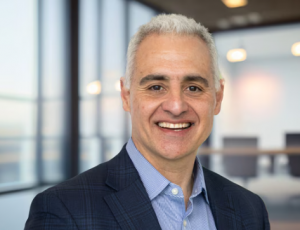 INFRA
INFRA
 INFRA
INFRA
 INFRA
INFRA
Shares of the computer chipmaker NXP Semiconductors N.V. fell more than 7% in extended trading today after it reported lower profitability on declining revenue and revealed its longtime Chief Executive Officer Kurt Sievers will step down at the end of the year.
Sievers (pictured) is planning to retire at the end of October, and has already handed over the title of company president to his planned successor, Rafael Sotomayor, executive vice president and general manager of NXP’s Secure Connected Edge division.
The company reported first-quarter earnings of $2.64 per share, beating the Street’s forecast of $2.58 per share. Revenue for the period fell 9% from a year earlier to $2.84 billion, though it came in just ahead of the analyst consensus estimate of $2.83 billion.
Despite beating expectations, the declining revenue had a big impact on the company’s profitability. NXP reported net income for the quarter of just $490 million, down 23% from the $639 million profit it recorded in the year-ago period.
Sievers said in a statement that the company continues to navigate a challenging market, beset by macroeconomic factors beyond its control.
“We are operating in a very uncertain environment, influenced by tariffs with volatile direct and indirect effects,” Sievers told investors. “Considering these external factors, we are redoubling our efforts to manage what is in our direct control, enabling NXP to drive solid profitability and earnings.”
Nonetheless, NXP was able to offer optimistic guidance for the coming quarter, saying it expects $2.9 billion in second-quarter sales at the midpoint. Wall Street is looking for second-quarter revenue of just $2.87 billion.
Investors may well have been more concerned about the surprise news that Sievers is set to step down from his role as CEO at the end of the year. In a statement, the company said Sievers will hand over the reins to Sotomayor on Oct. 28. In the meantime, he’ll work closely with Sotomayor to help ensure a smooth leadership transition.

NXP’s incoming CEO Rafael Sotomayor
The company stressed that Sievers’ retirement was a personal decision and that there were no issues with the board of directors or concerns about its performance.
NXP Chair Julie Southern said Sotomayor has played an “integral part” in helping to shape the company’s strategy and success over the last decade. The incoming CEO joined NXP in October 2014 as senior vice president and general manager responsible for its connectivity and security products. Prior to joining NXP, he spent 11 years at the rival chipmaker Broadcom Inc., where he held a number of senior marketing roles.
“We are confident he is ideally suited to assume the role of president and CEO and execute the company’s vision for leadership in intelligent systems at the edge and within the automotive and industrial and IoT end markets,” Southern said.
Sotomayor will have his hands full, though, for the company has been losing revenue in all four of its major business segments for some time. Unlike other chipmakers, such as Nvidia Corp., NXP has been unable to capitalize on the demand for artificial intelligence because it’s focused much more on legacy chips.
In the automotive business, it has struggled with declining consumer interest in electric vehicles, and that showed in its latest results. The automotive segment delivered revenue of $1.67 billion in the quarter, down 7% from a year earlier and lower than the $1.69 billion analyst forecast.
NXP’s second-biggest segment, Industrial & IoT, suffered even more, with revenue declining by 11% year over year to just $508 million. Sales in the Mobile business segment fell 3% to just $338 million, while the “Communications, Infrastructure and Other” business reported sales of $315 million, down 21% from a year ago.
Holger Mueller of Constellation Research Inc. said NXP deserves some kudos for delivering to expectations and remaining profitable during such dire market conditions. He added that Sievers is likely one of the main reasons for this, which is why investors seem concerned about the prospect of his retirement.
“Sotomayor has to find a way to steady the ship, and that won’t be easy, but one advantage for NXP is that it’s remarkably differentiated across four major chip market segments,” Mueller said. “One question for the new CEO is which of those segments should be prioritized in order to try and return the company to growth?”
During the quarter, NXP continued its recent spending spree, closing on its third major acquisition of the year in February when it paid $307 million to buy Kinara Inc., a California-based maker of neural processing units for AI workloads at the edge.
That acquisition came about a month after NXP paid $625 million to acquire the autonomous vehicle software company TTTech Auto AG. In December, it shelled out another $242.5 million to buy the automotive connectivity systems manufacturer Aviva Links Inc.
Support our mission to keep content open and free by engaging with theCUBE community. Join theCUBE’s Alumni Trust Network, where technology leaders connect, share intelligence and create opportunities.
Founded by tech visionaries John Furrier and Dave Vellante, SiliconANGLE Media has built a dynamic ecosystem of industry-leading digital media brands that reach 15+ million elite tech professionals. Our new proprietary theCUBE AI Video Cloud is breaking ground in audience interaction, leveraging theCUBEai.com neural network to help technology companies make data-driven decisions and stay at the forefront of industry conversations.